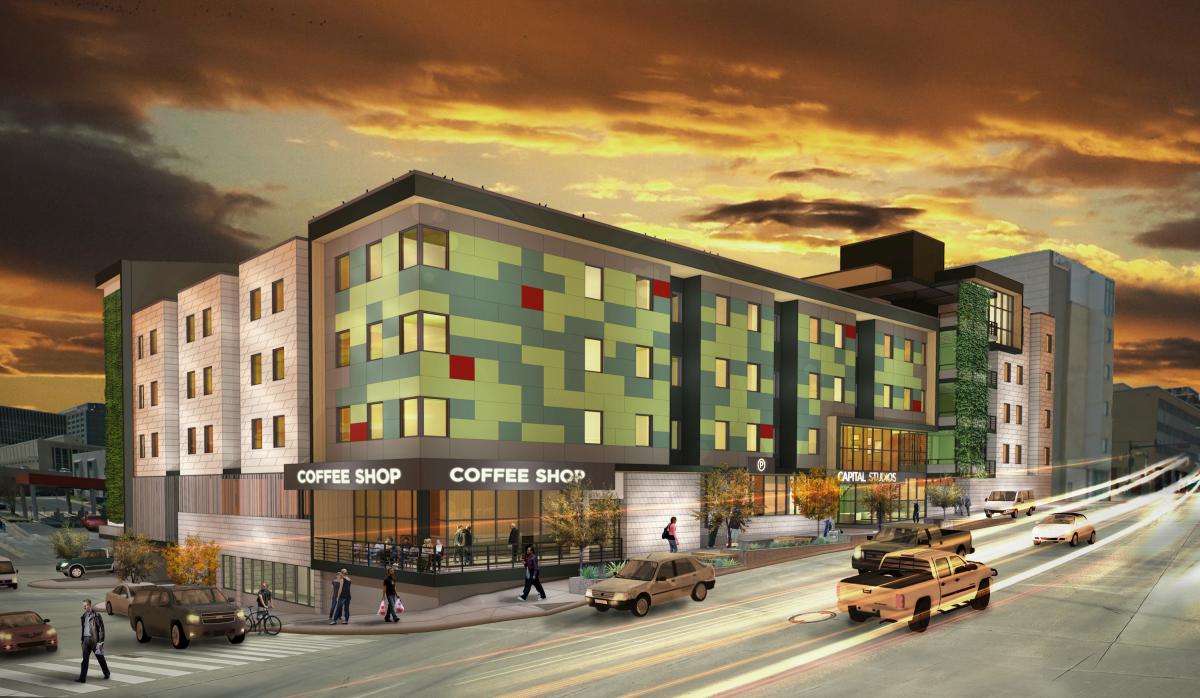Implementing Permanent, Affordable Solutions for Austin
Have you noticed the cool, new colorful building at the corner of 11th Street and San Jacinto? You may have thought it’s yet another new expensive downtown condo building, but for a lucky group of Austinites, it’s actually the first new affordable housing community built in the downtown area in over 45 years! Foundation Communities has created the opportunity for 135 low-income individuals, including downtown service workers and those who have experienced homelessness, to live in the heart of downtown.
 The development, called Capital Studios, opened in December of 2014 and offers 135 efficiency apartments for single adults with rents that range from $399-$665/month, bills included. Using $11.7M in state low-income housing tax credits, leveraged by $4.7M in City of Austin funding, and another $5M from other sources, this architecturally vibrant green building also includes over 30 units of Permanent Supportive Housing for individuals who have experienced chronic homelessness.
The development, called Capital Studios, opened in December of 2014 and offers 135 efficiency apartments for single adults with rents that range from $399-$665/month, bills included. Using $11.7M in state low-income housing tax credits, leveraged by $4.7M in City of Austin funding, and another $5M from other sources, this architecturally vibrant green building also includes over 30 units of Permanent Supportive Housing for individuals who have experienced chronic homelessness.
Permanent Supportive Housing, commonly referred to as PSH, is a model that has been gaining traction in the Austin community since 2010 when the City Council approved the City of Austin Permanent Supportive Housing Strategy. The strategy was the culmination of years of work by local homeless service providers including the Ending Community Homelessness Coalition, Reentry Roundtable, Healthcare District, Austin Travis County Integral Care (the local mental health authority), local hospitals, housing authorities, and the City and County. The community worked with the Corporation for Supportive Housing to understand available tools and to put together a specific strategy for Austin.
PSH is a nationally recognized best-practice model that pairs subsidized rental housing with (voluntary) intensive case management and other social services to bring housing stability to individuals and families who have experienced chronic homelessness. Not only is housing the homeless the humane thing to do, but getting folks into PSH is a proven method of lowering costs on the public. You may wonder how paying for someone’s housing and social services can save public money? Well, the target population for PSH - the most vulnerable chronically homeless - are also often the top users of our public systems: emergency rooms, jails, courts, police, fire and emergency medical services. The costs to use those systems - typically for reasons that are unavoidable simply for being homeless - are very high; multiple studies in other communities have found that the average cost for stably housing someone with services actually costs less than leaving them on the streets because a housed person uses fewer of those systems.
In 2010, the Austin City Council set a community goal of creating 350 new units of PSH over the next four years. With the help of numerous local public, private, and non-profit agencies, that goal was met in the fall of 2014, and Council set a new goal of creating another 400 units of PSH in the next four years, 200 of which should be “Housing First” PSH. Housing First is a PSH philosophy that requires placing clients immediately into housing, with the lowest barriers possible (low criminal background requirements, no sobriety requirements, etc.) so that clients can begin to work on challenges that have contributed to their chronic homelessness. The idea is that people will have a greater chance of success working on issues if they first have a safe place to live.
 |
| Rendering of the Austin Travis County Integral Care Housing First PSH Development |
In connection with this new goal, the Austin Housing Finance Corporation, in partnership with the City of Austin Health and Human Services Department, issued the first ever Request for Proposals for a team that would create a single development with at least 50 Housing First PSH units. The winning proposal was Austin Travis County Integral Care (ATCIC), who will build the first Housing First development in Austin, creating homes for 50 residents! This housing development will include, among other amenities, an integrated care clinic on the ground floor.
It’s a reality that living in Austin is becoming more and more expensive. The more we can implement creative solutions like Permanent Supportive Housing and create more affordable options for all people, the better off we are as a community.
